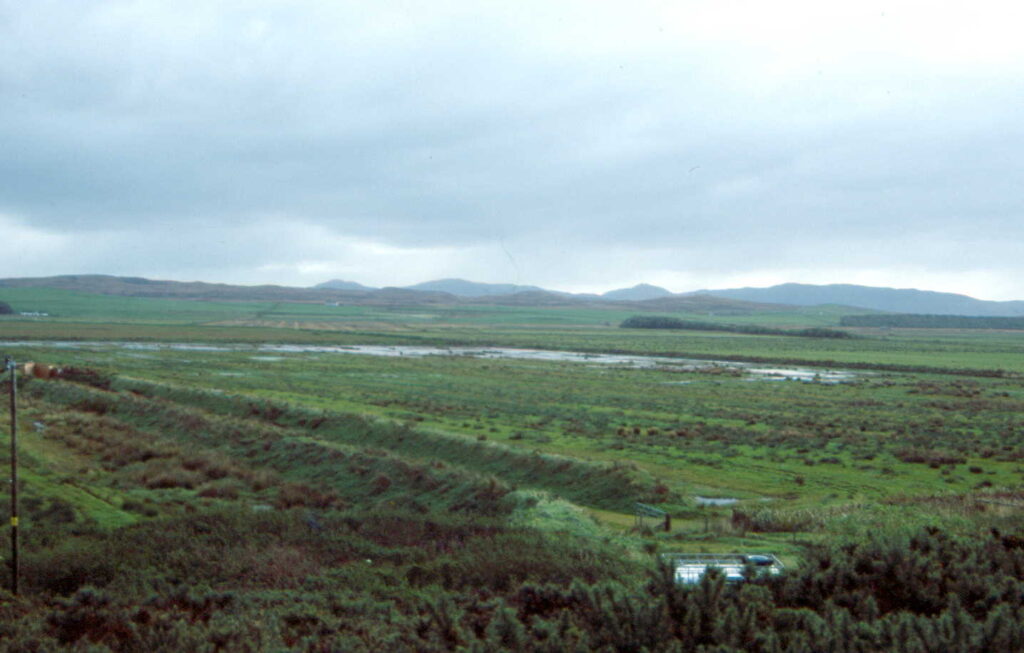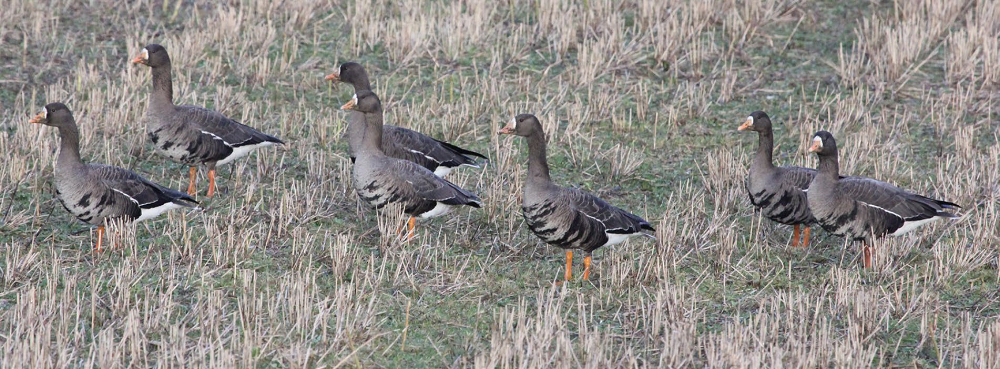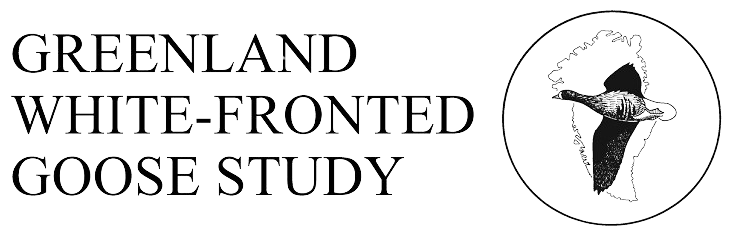
History
Islay has likely been the major wintering resort for Greenland White-fronted Geese for some considerable time, at least for the last 150 years. The species was already plentiful there in the 1870s (Grey 1871) and was described as “undoubtedly its headquarters” for the whole country by Harvie-Brown & Buckley (1892). Berry (1939) seemed to consider it the most important resort in Scotland of his time, with numbers there having “increased enormously” during the first 30 years of the 1900s. A-W (1963) described the flocks on the island increasing from November onwards to a February peak of 1,500-3,000 and he was also of the opinion that numbers had increased. R&O (1979) produced annual peak counts back to 1962/3, reproduced in the figure below, but cautioned that in the years before 1967/8, few of the counters covered all of the now better known White-fronted Goose haunts on the island, so it is difficult to measure the real magnitude of increases in numbers preceding that time. Nevertheless, there are real signs of a gradual increase in number (despite the hunting kill of those times) from 1,000-1,300 in the early 1960s up to just over 4,000 in the mid to late 1970s. Following protection from hunting, the numbers increased rather more dramatically to peak at 15,408 in 1998, with a major decline between 2002/3 and 2003/4 but with a rapid slippage back to 7,800-8,000 birds in the last 3 years.
Status
International importance (R&O 53). Islay represents the single largest aggregation of the population in Britain. Although traditionally presented as one site, the island is in reality a vast complex of interlinked sites, with well defined feeding areas associated with distinct overnight and disturbance refuges and roost. However, the situation is complicated by switches between feeding areas, with birds from different parts of the island often mixing when feeding on stubble in autumn and on root crops when these are harvested at other times of the winter to muddy the picture. This makes it difficult to understand how loss of habitat or disturbance pressures at one part of the site may impinge on the overall value of the island to the geese, especially as there is a wealth of habitat available. Observations of colour marked geese over several years have shown that separate flocks occur on the island each with discrete feeding and roosting areas giving some confidence in understanding the flock structure on the island. Considerable analysis of these flock ranges was carried out by WWT under contract to SNH which will not be summarised here (MacKay 1992, Ridgill et al. 1994). For the pruposes of this treatment, we consider the site as one entity. For the island of Islay, very detailed counts have been undertaken over many years. Since there are set count routes defined since monitoring began there in 1981/82, this gives an opportunity for detailed analyses of the counts there (see figure).
Maximum winter counts:
Breeding success:
An excellent range of age ratio data is available over many years which shows variable but reasonably good breeding success, with much lower output since the late 1990s (see first diagram below). The annual production follows that of the most important Irish wintering site for the population, Wexford Slobs (see second diagram below).
Feeding sites and habitat: Greenland White-fronted Geese traditionally foraged on the wetter less intensively managed grassland of the island, but have increasingly shifted to more improved grassland and intensively managed reseeds as time has gone on. Nevertheless, the species still grub for the below ground parts of buttercups Ranunculus and floating flote grass Glyceria in the wettest parts of fields as well as grazing the more palatable bred agricultural grasses which ensure higher intake rates. Many geese still use natural mire vegetation even by daytime. gleaning of stubble and some root crops occurs, especially early in the winter, but almost all of the birds resort to bog vegetation to roost at night, where exploitation of traditional food items is common.
Roosting sites: Geese use a very large range of different lochs, lochans, patterned mires abandoned peat cuttings and even pools in fields (especially on moonlit nights as shown by radio tracking, see Ridgill et al. 1994) as roost sites (see MacKay 1992 for details). Many of the peatland and lochan sites are used for supplementary feeding on peatland species at night.
Habitat change: Claim of rough grazing continues on Islay, but the pace of drainage and agricultural improvement in recent years has slowed. The large RSPB reserve at Gruinart manages fields sympathetically for the geese at this site.
Aircraft disturbance: Not known in context, there is restricted low flying because of the island airport which in turn causes regular traffic, but it is thought this has little impact on the geese.
Hunting disturbance: Wildfowling is common and scaring of this species and more especially Barnacle Geese is widespread and organised on the island that causes disruption to normal feeding patterns.
Agricultural disturbance: Unknown to what extent this has affected geese on the island.
Site safeguards or disturbance refuge: Geese feed and roost within a number of SSSI with the following designations:
Eilean na Muice Duibhe (Duich Moss) NCR SSSI SPA and Ramsar site
Bridgend Flats NCR SSSI Ramsar and SPA
Feur Lochain NCR SSSI Ramsar and SPA
Glac na Criche NCR SSSI Ramsar and SPA
Gruinart Flats NCR SSSI SPA and Ramsar site
Rhinns of Islay NCR SSSI SPA and Ramsar site
Laggan Peninsula NCR SSSI SPA
Oa proposed Ramsar and proposed SPA
Loch Gruinart RSPB reserve
SNH Natural Heritage Zones/Area: Argyll West and Islands
Threats: There are high levels of shooting on the island, but what extent this has any effect on the numbers and distribution of White-fronted Geese that were a quarry species and shot on the island until 1982, remains obscure.
Linkages with other sites: 444 different marked Greenland White-fronted Geese have been seen in on Islay and summarising the movements of these birds requires a web site on its own! Broadly, the majority of long term regularly wintering birds originate from marking projects in Eqlungmiut Nunaat (1979 and 1984) and in Isungua (1990s), but these are supplemented by very large numbers of birds marked elsewhere, the vast majority of which originate from Wexford where most birds have been marked. Many have occurred very briefly on autumn migration, stopping en route to their ultimate wintering area at Wexford, a few have done so in spring. Others have stayed for just one winter on Islay before returning to Wexford, or moving elsewhere, as there is a small number of birds that shift wintering site almost every season.
References
Gray, R. 1871. The Birds of the West of Scotland, including the Outer Hebrides. Thomas Murray & Son. Glasgow.
Harvie-Brown, J. A. & Buckley, T. E. (1892) A Vertebrate Fauna of Argyll and the Inner Hebrides. David Douglas, Edinburgh.
MacKay, C.R. (1992) Islay Greenland White-fronted Goose project – progress report winter 1991-92. Wildfowl & Wetlands Trust report to Scottish Natural Heritage.
Ridgill, S.C., MacKay, C.R. & Rees, E.C. (1994) Greenland White-fronted Geese wintering on Islay. Wildfowl & Wetlands Trust report to Scottish Natural Heritage.

